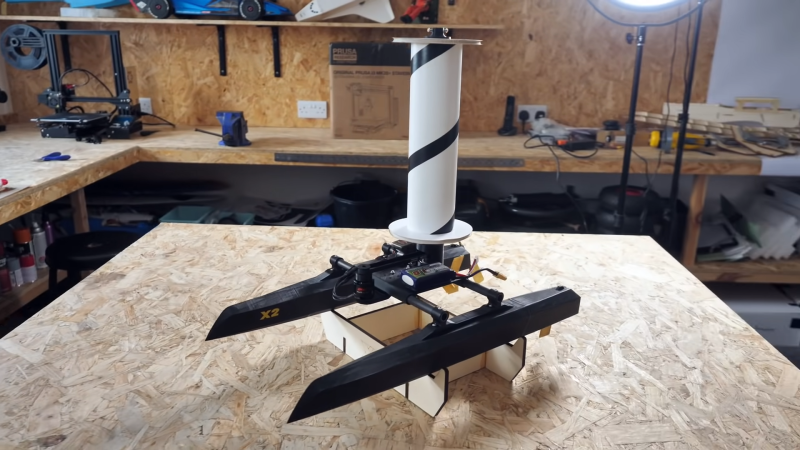The Magnus effect is a interesting and useful phenomena. [James Whomsley] from [Project Air] decided to put it to work on a small radio-controlled boat, successfully harnessing the effect. (Video, embedded after the break.)
The Magnus effect is an interesting thing, where fluid flowing over a rotating object generates an aerodynamic force at a right angle to the direction of the flow and the axis of rotation. (It’s why curveballs curve.) This can be used for propulsion on a boat, by spinning a tall cylinder called a Flettner rotor. This takes advantage of Magnus effect to generate thrust.
The boat uses a 3D-printed hull, sealed up with a leak sealer spray and lots of spray paint to avoid leaks. In the center of the catamaran design, there’s a spinning rotor belt-driven by a brushless motor. Outside of the rotor for thrust, a simple rudder is used for steering.
With the rotor turning, the boat was able to successfully sail along with the benefit of the thrust generated from the wind. However, there were teething issues, with heavy winds quickly capsizing the boat. [James] realized that adding some proper keels would help avoid the boat tipping over.
We’ve seen [James] around these parts before, namely with the Magnus-effect aircraft that preceded this build.
[Thanks to Baldpower for the tip!]
















hey, if it was upside down would it still work?
Well as the article says “The Magnus effect is … where fluid flowing over a rotating object generates an aerodynamic force at a right angle to the direction of the flow and the axis of rotation.” and since water is a fluid I suppose it would work, but it would probably take more power due to the viscosity and mass of water compared to air. It would be in interesting alternative to a propeller though, just stay out of the shallows.
Adding a proper keel, rather than a skegg (kind what was added in the video). Something much longer and broader, ideally with a bit of weight to it (3d printed and filled with bismuth shot or 1/8″ steel flat bar works well). Of course the added weight might not work that those hulls and leave you with too little free-board.
Great project! Hope you take this further.
Well, multihulls have. *lot* more initial stability and tend to remain pretty level, till all of a sudden they don’t, as the video shows. A deeper keel would just delay the tripping over point. A monohull tends to heel and lose grip more gradually. It’d be interesting to see if this propulsion works when heeled.
Maybe put the rotor on a gimbal so it remains vertical while hull moves?
Catamarans generally don’t have large or weighty keels for stability, but use their width to create righting moment. The hulls are too close together and too small for the “sail” in this case. Dagger boards might help with upwind sailing though.
I like your train of thought. Weight is the enemy and the primary reason catamarans are so fast. Longer, wider with dagger boards closer the point of power/ rotor to create directional stability.
I guess this Magnus Effect sail doesn’t spill the wind like a traditional sail either. So doesn’t depower as much as the boat heels over.
How much power does this use for the thrusts it produces and the weight it propels, maybe you could power it with solar cells?
I recall that Jacques Cousteau built a full size ship with two of these powering the propeller. Can this be researched?
I remember Jacques Cousteau had a vessel with 2 turbo sails called the Alcyone. IIRC those have an opening on one side along the length and air is push up the tube/mast/sail(?) and a pressure differential is created on one side of the sail. They did rotate, but only to vector the thrust, they didn’t spin.
Vikingline cruise ship they are testing that in real life (Finland)
Is it less than realistic for a cylindrical sail to turn a turban to produce sufficient current for an electric motor?